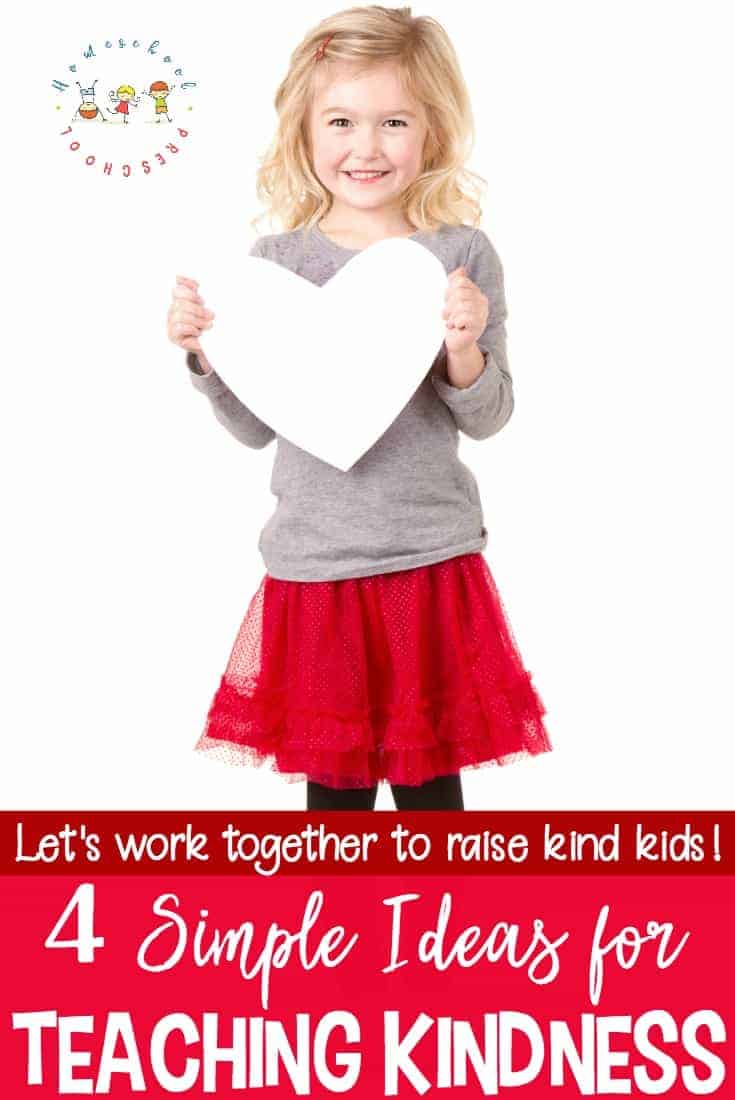4 Ideas for Teaching Kindness to Preschoolers
Come discover four simple ideas for teaching kindness to preschoolers. Raising kind children is a great way to pave the way for a world full of kind adults.

Do your kids struggle with understanding what kindness is and what it looks like in action? If so, try these simple ideas to intentionally focus on kindness with your preschoolers.
Not only will it lay a foundation for growing kind adults, but it will help build relationships within your family today.
Teaching Kindness to Preschoolers
Model it.
One of the most important things we can do for our children is to model good behavior. You cannot expect your preschooler to “do as I say, not as I do.” They can’t separate the two.
So, if we want to raise kind kids, we need to be kind adults. Speak kindly to your child. Praise their efforts when they’re trying hard and when they make right choices. Say thank you. Teach them gratitude. Work as a team to demonstrate kindness by completing some random acts of kindness while you’re out and about.
When our children see us being kind to others, they can begin to “see” what kindness looks like.
Be aware of your surroundings.
Again, we’ll talk a bit about modeling. Teach your child to see opportunities to be kind. When a sibling is struggling to pick up something heavy, encourage your child to show that sibling kindness by offering to help. “I can see your sister is having a hard time picking up that box. I bet she’d love it if you helped her.”
Your child offers to help you do the dishes, clean a room, or put away groceries. Let them help (even if it makes your task a tiny bit harder). Then, be sure to point out how it was so kind of them to help you.
Not only will they love the praise, they will begin to see how their actions are kind when they are helping others.

Create a kindness jar.
It’s easy to tell your child to “be kind.” It’s another for your preschooler to actually know what that means. They tend to have a difficult time understanding abstract concepts, and kindness is abstract.
One simple thing you can do to show kindness in a very concrete, visual way is to create a kindness jar. Whether your focus for teaching kindness is on kindness in your home or outside, I recently shared eight fun ideas for creating a family kindness jar. These ideas help you teach kindness and empathy in the home, to strangers, and in the classroom.
Focus on the positive.
All too often, I find myself focusing on what my children aren’t doing right. They aren’t doing their chores. They are too whiny. They are arguing – again! I am quick to get on to them and correct their behavior.
I am not as quick to notice when they’re making right choices. I am much slower to give praise or thanks when my kids are behaving. However, when we focus on teaching kindness to preschoolers, we need to intentionally focus on the kind things they do.
When we notice that an older sibling is entertaining a younger one without being asked, we need to be quick with our thanks and our praise. We need to let them know how they’re actions have helped us tackle a chore, make a phone call, or read a few pages in our book.
When we take notice of their kindness, we help them know that their actions matter. Their kindness helps make someone else’s day better/easier/more pleasant.
When we teach our preschoolers to be kind to one another and to use acts of kindness to help people around them, we are paving the way for a world full of kind adults. That, my friend, will make for a much better place for all of us to live in!
Resources for Teaching Kindness to Preschoolers
If you need a few more ideas for teaching kindness, check out these resources:
• Kindness Matters Cards – Change the world with one kind act at a time!
• Print out a list of 100 Acts of Kindness for Kids and let them color a star every time they do something kind.
• Kindness Counts: A Story for Teaching Random Acts of Kindness – When Cade’s and his family find out their ice cream order was paid for by another patron, they continue paying it forward, and so starts the discussion of random acts of kindness. Cade takes this idea and runs with it, showing unexpected kindnesses to others. But when Cade’s dad would like him to donate some of his own toys, he has a hard time. Will Cade be able to learn the importance of being kind to others, even when it isn’t easy?
• Kindness Counts: A Story for Teaching Random Acts of Kindness – When Mrs. Ruler asks five of her kindergarteners to miss recess, she’s got a special plan up her sleeve. She’s about to teach a new golden rule: KINDNESS IS COOL!
• Kindness Elves – The Kindness Elves™ send a positive message of emphasizing kindness, sharing and gratitude within our children. There is plenty of magic and fun, but none of the bribery or focus on behaving well to earn a reward.
What are you doing today to teach kindness to your preschoolers?
Related Posts

Tara is the brains behind Homeschool Preschool, where her journey from preschool and public school teacher to homeschooling mom of three fuels her passion for early childhood education. With a blend of expertise and firsthand experience, Tara’s writings offer practical tips and engaging resources to support families in creating meaningful learning adventures at home.




One Comment